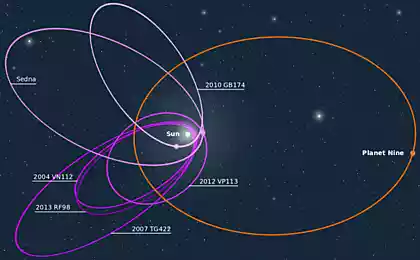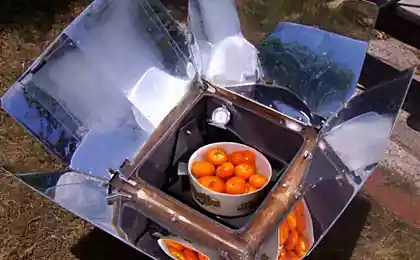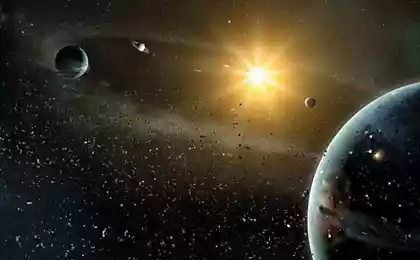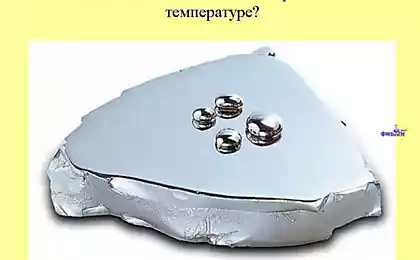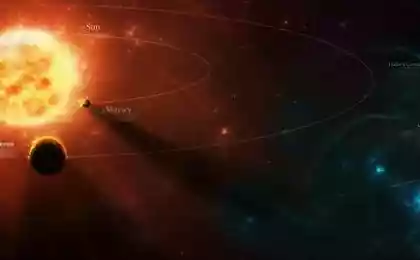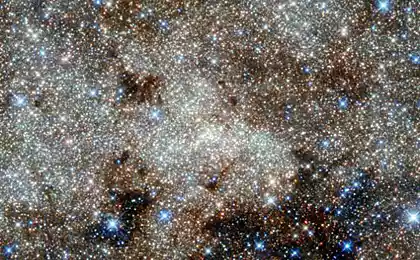884
10 strange objects in the solar system, about which we know very little
Space is full of syurprizovK date using spacecraft "Kepler" astronomers were able to locate and confirm the existence of planets 4896. And recently it opened a gas giant with an enormous system of rings 160, so it may seem that we have already know something about what is happening in space.
Nevertheless, the universe never ceases to present us with surprises. And suddenly it turns out that we do not fully understand even with what is happening in our own solar system.
1. Orc and VantVse we know about Pluto. Particular attention to him was in 2006, when he was deprived of the status of a full-fledged planet.
But have you heard ever about the object, which is sometimes called the "anti-Pluto»?
Object 90482 Orc - is the object of the Kuiper Belt, which has almost the same orbital period as Pluto, almost the same angle of inclination of the axis, and is almost the same distance from the sun.
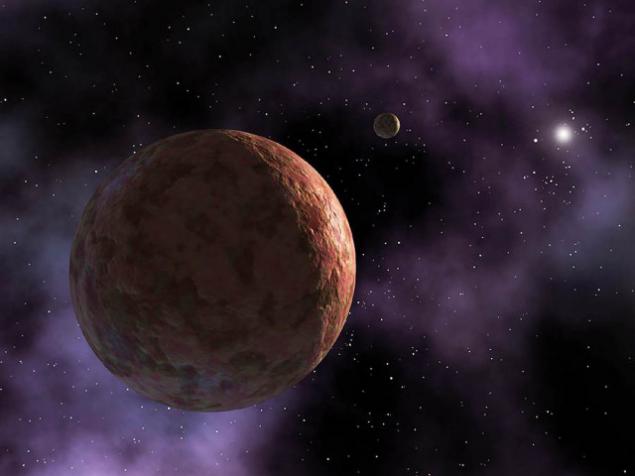
Like Pluto, and Orc is a 2: 3 orbital resonance with Neptune, but Orc little differently oriented in space. Pluto and Orca are almost identical, and moreover, Orca and Pluto have satellites, which are quite large in comparison with these planets.
Pluto, Charon is half Pluto and the satellite Orc Vant, according to various estimates, is one third the size of the Orca.
The name "Orc" was chosen because it was the Etruscan equivalent of Roman word "Pluto." Orc crystal surface covered by ice from water and possibly from ammonia, which indicates that in the past was Orca cryovolcanism and geological activity. If the presence of ammonia in the Orca is officially confirmed, the Orc will help professionals to understand the mechanism of formation of other trans-Neptunian objects.
2. (90) AntiopaChislo 90 in the title of this object indicates that the asteroid Antiope was discovered nineties in a row, though this fact is still considered controversial.
The fact that the orbit of the object is within the asteroid field between Mars and Jupiter, and, most interestingly, Antiope - the first double asteroid, which was able to open a scientist.

Since the discovery of a single asteroid Antiope was considered, but in the year 2000 with a 10-meter telescope, "Keck-2", located at the observatory in Hawaii, a team of astronomers has found that this asteroid is actually made up of a pair of objects. The size of each of them about 86 kilometers, and the distance that separates them, is only 171 km.
In fact, with the same pair of objects orbiting in astronomy is not uncommon, however, the difference in weight between the components of Antiope is so small that the best way to imagine what she looks like, is to imagine a pair of rotating balls for bowling related piece of string.
3. Hexagon SaturnaVse know about Saturn's rings, but have you heard anything about the shape of his clouds? In the early 80's apparatus "Voyager" made a surprising and unprecedented discovery, which was confirmed later, after arriving at Saturn vehicle "Cassini».

The entire north pole of Saturn covers a huge storm in the form of a hexagon, each side is larger than the diameter of the Earth. This storm is raging there for more than 30 years.
Incredibly, the hexagon does not move with the rest of the clouds on the planet, and its amazing geometric accuracy gives rich food for all kinds of pseudoscientific theories (fortunately, most of them can hardly be called serious).
Although fully explain this phenomenon so far failed, scientists try to explain what is happening on Saturn using fluid dynamics.
Laboratory experiments have shown that in a liquid, the center of which rotates faster peripherals, there are so-called "verge". If the speed is very high, in a liquid form polygons. The wind speed in the 'hexagon' on Saturn reaches 322 kilometers per hour. Perhaps this speed and creates less clearly geometric shape.
4. HaumeaPrezhde than 136,108 Haumea facility received its official name, he was known as "Santa" because it opened December 24, 2004.
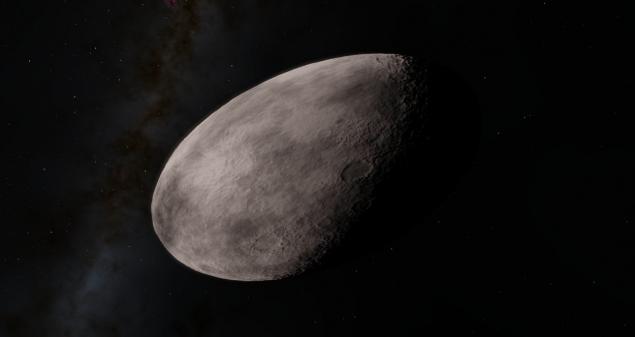
This is an unofficial name, in fact, quite appropriate since Haumea - is very "gifted" and a unique dwarf planet. Those of skill was very difficult to carry out measurements of Haumea due to its extremely rapid rotation. It rotates faster than any of the known solar system bodies to science.
This in itself creates a rotation not too many problems, but because of him Haumea formed not like the other planets.
It consists of rock and ice, gravity there is very low, but because of the monstrous centrifugal force of the planet's surface evolved into what is called "oblique ellipsoid».
This means that the distance between the poles of the planet is 996 kilometers, and the long axis of the ellipsoid is 1960 kilometers.
By the way, these properties associated with rapid rotation, has not only the planet. Similar properties have and its satellites - Hiiaka and Namaka, whose mass is only 6% of the mass of our moon.
5. Pan and Atlas of the two moons of Saturn have much in common, besides they are located closest to Saturn.
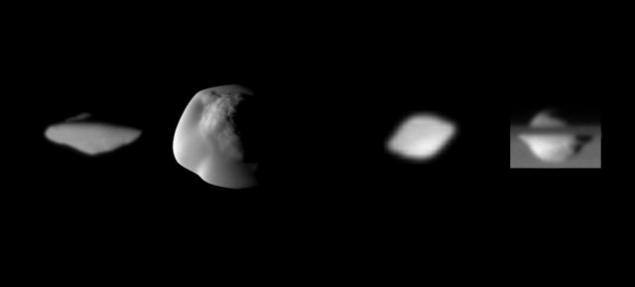
And especially these satellites are doing what they seem to have copied the rings of Saturn itself and as a result began to resemble the shape of a UFO films 50s.
Ban, who is also known as the "shepherd moon", was named in honor of the Greek god of shepherds, and Atlas was named after the titan who held the sky on his shoulders.
In this pair of moons Atlas is more flat, the distance between the poles of only 19 km. But the "waist" in his wide - 46 kilometers. Length of the equator of the moon can not be explained by the same processes that occur on Haumea, as the speed of their rotation is not as mad.
As a result of extensive computer modeling of the University of Paris found the answer: the thing is akkreatsionnyh drives: the equator of the moon gradually increased and leveled due to the fact that it adheres to the surrounding debris. During the formation of Saturn's moons were formed around them and small akkreatsionnye discs, consisting of dust and debris, are present in abundance in the rings of Saturn. The gradual increase of the drive and led to a form of moons that we are seeing now.
6. 2008 KV42Vsё the same reason so many astronomical objects has the annoying name?

Fortunately, the comet is called the "fight". It is so named in honor of Dracula, which was the ability to walk on walls. But walking on the walls due to the comet? Drac - this is the first trans-Neptunian objects, which, as it turned out, revolves around the Sun in a retrograde orbit, that is, backwards. It is slow, circulation period of 306 years (although it is still unclear where is the connection with walks on the walls).
So far in the solar system there are several objects with retrograde orbits. One of these objects is Halley's Comet, whose orbital path passes close enough to the sun. Draco never approaches the Sun at a distance greater than 20 distances from the Sun to the Earth, which is roughly equivalent to the orbit of Uranus.
This feature of the comet could be a link between Halley's comet, and other objects from the Oort cloud, which, presumably, is the source of comets for our solar system, and this link may help scientists explain the specifics of the formation of comets, which at the moment remains a mystery for science.
There are many versions, attempting to explain why the orbit of fight different from all others. The most interesting theory is that this comet has not been formed, along with the rest of the solar system, because if that were so, it would have orbited in the same direction as that of all other objects. It is possible that a comet just got into our system in the trap, thus giving us the opportunity to get an unprecedented amount of information about space.
7. TritonVy certainly at least once heard the name. Triton weight of approximately 99, 5% of the total weight of all the known satellites Neptune. The apparatus "Voyager", flying past the Triton in 1989, showed that Triton's very complicated geological history, evidence of which is cryovolcanism. On the satellite still have active volcanoes, but they do not emit lava and ash, as on Earth, but water and ammonia.

Triton slightly smaller than our moon, and it is the only moon in the solar system, which moves in the opposite direction to the rotation of Neptune. And as Triton - one of the major moons of the solar system (he even larger than Pluto), he has enough gravity to maintain its own atmospheric layer. But the atmospheric pressure on Triton 50 000 times below the ground, so you could hardly deal with kiting there.
Lastly, Newt - is one of the objects with a very high reflectivity, it is capable to reflect 60 to 95% of the light incident on its surface. For comparison, our moon reflects only 11% of the incident light on it.
8. Additional ring SaturnaSaturn in this article mentioned more than once. This planet is known for its unusual rings, composed of ice and dust. But recently, in 2009, experts found out that Saturn has one more, additional and incredibly huge ring. From the main rings it is rejected at 27 degrees away from Saturn to the ring is about 128 radius of the planet. Ring unloaded so that it can be seen only in the infrared spectrum. That it may be the reason that one of Saturn's moons, Iapetus, referred to as "two-faced", one of its hemisphere black as soot, and the second - as white as snow.

In the same ring passes the orbit of another moon of Saturn - Phoebe. Perhaps precisely because of this satellite and ring emerged. The dust ejected Phoebe settles on Iapetus, whose orbit intersects the ring. Whenever Japet passes through the ring, the particles contained in the ring, it collects on the equator. Perhaps it is because of this process of Iapetus after hundreds of thousands of years and gained its striking appearance.
9. "Siamese Moon" satellites Janus and Epimetheus are also known as "Siamese moon" because they share the same orbit, and the distance between them is only 50 kilometers. It is even smaller than the radius of the satellites themselves.

Because of this, they have to dance to their gravitational tango, which literally causes them to change places every four years.
Initially, the scientists could not understand why the data they receive from the moon, which they called Janus, do not meet their expectations. And only in 1978, 12 years after the opening of the general orbit "Siamese moons", experts have realized that what they call Janus - is actually two different moons. This assumption was confirmed during the flight apparatus "Voyager" in 1980. Interestingly, in the area of satellite orbits observed subtle ring of dust. This suggests that these two moons were once a moon, which for some reason split, forming a small amount of debris and dust.
10. KruitniOznakomivshis with the strangest things in the solar system, let's look at the earth and discuss one very controversial issue of the second satellite of our planet.
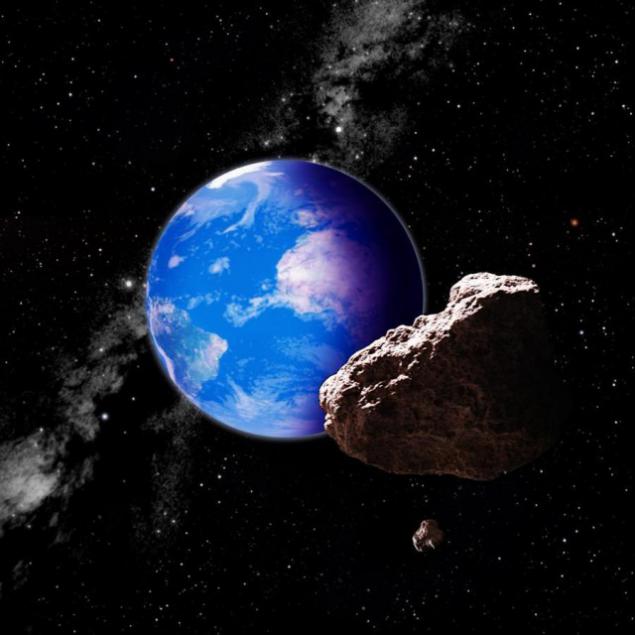
Astronomers look for the second satellite of the Earth since 1846. Frederic Petit was the first to assert that he had found a second moon. He suggested that the period of its revolution around the Earth at least three hours, and that it is taking place just 11 kilometers above the surface of our planet. Since then, many astronomers have claimed to have found a second moon, but could not prove it.
Kruitni 3753 - an asteroid, which makes a complete revolution around the Sun in 364 days, and is in a prime orbital resonance with the Earth. This means that for a short time each year 5-kilometer asteroid Kruitni becomes part of the Earth system. Each November, he comes to the Earth as close. Technically considered this asteroid second satellite of the Earth is impossible, as, approaching as close as he followed a long time away from our planet. But still nice to think that every year, at the same time to visit us comes an old friend.
via listverse.com/2015/03/05/10-bizarre-objects-you-didnt-know-were-in-our-solar-system/
Nevertheless, the universe never ceases to present us with surprises. And suddenly it turns out that we do not fully understand even with what is happening in our own solar system.
1. Orc and VantVse we know about Pluto. Particular attention to him was in 2006, when he was deprived of the status of a full-fledged planet.
But have you heard ever about the object, which is sometimes called the "anti-Pluto»?
Object 90482 Orc - is the object of the Kuiper Belt, which has almost the same orbital period as Pluto, almost the same angle of inclination of the axis, and is almost the same distance from the sun.

Like Pluto, and Orc is a 2: 3 orbital resonance with Neptune, but Orc little differently oriented in space. Pluto and Orca are almost identical, and moreover, Orca and Pluto have satellites, which are quite large in comparison with these planets.
Pluto, Charon is half Pluto and the satellite Orc Vant, according to various estimates, is one third the size of the Orca.
The name "Orc" was chosen because it was the Etruscan equivalent of Roman word "Pluto." Orc crystal surface covered by ice from water and possibly from ammonia, which indicates that in the past was Orca cryovolcanism and geological activity. If the presence of ammonia in the Orca is officially confirmed, the Orc will help professionals to understand the mechanism of formation of other trans-Neptunian objects.
2. (90) AntiopaChislo 90 in the title of this object indicates that the asteroid Antiope was discovered nineties in a row, though this fact is still considered controversial.
The fact that the orbit of the object is within the asteroid field between Mars and Jupiter, and, most interestingly, Antiope - the first double asteroid, which was able to open a scientist.

Since the discovery of a single asteroid Antiope was considered, but in the year 2000 with a 10-meter telescope, "Keck-2", located at the observatory in Hawaii, a team of astronomers has found that this asteroid is actually made up of a pair of objects. The size of each of them about 86 kilometers, and the distance that separates them, is only 171 km.
In fact, with the same pair of objects orbiting in astronomy is not uncommon, however, the difference in weight between the components of Antiope is so small that the best way to imagine what she looks like, is to imagine a pair of rotating balls for bowling related piece of string.
3. Hexagon SaturnaVse know about Saturn's rings, but have you heard anything about the shape of his clouds? In the early 80's apparatus "Voyager" made a surprising and unprecedented discovery, which was confirmed later, after arriving at Saturn vehicle "Cassini».

The entire north pole of Saturn covers a huge storm in the form of a hexagon, each side is larger than the diameter of the Earth. This storm is raging there for more than 30 years.
Incredibly, the hexagon does not move with the rest of the clouds on the planet, and its amazing geometric accuracy gives rich food for all kinds of pseudoscientific theories (fortunately, most of them can hardly be called serious).
Although fully explain this phenomenon so far failed, scientists try to explain what is happening on Saturn using fluid dynamics.
Laboratory experiments have shown that in a liquid, the center of which rotates faster peripherals, there are so-called "verge". If the speed is very high, in a liquid form polygons. The wind speed in the 'hexagon' on Saturn reaches 322 kilometers per hour. Perhaps this speed and creates less clearly geometric shape.
4. HaumeaPrezhde than 136,108 Haumea facility received its official name, he was known as "Santa" because it opened December 24, 2004.

This is an unofficial name, in fact, quite appropriate since Haumea - is very "gifted" and a unique dwarf planet. Those of skill was very difficult to carry out measurements of Haumea due to its extremely rapid rotation. It rotates faster than any of the known solar system bodies to science.
This in itself creates a rotation not too many problems, but because of him Haumea formed not like the other planets.
It consists of rock and ice, gravity there is very low, but because of the monstrous centrifugal force of the planet's surface evolved into what is called "oblique ellipsoid».
This means that the distance between the poles of the planet is 996 kilometers, and the long axis of the ellipsoid is 1960 kilometers.
By the way, these properties associated with rapid rotation, has not only the planet. Similar properties have and its satellites - Hiiaka and Namaka, whose mass is only 6% of the mass of our moon.
5. Pan and Atlas of the two moons of Saturn have much in common, besides they are located closest to Saturn.

And especially these satellites are doing what they seem to have copied the rings of Saturn itself and as a result began to resemble the shape of a UFO films 50s.
Ban, who is also known as the "shepherd moon", was named in honor of the Greek god of shepherds, and Atlas was named after the titan who held the sky on his shoulders.
In this pair of moons Atlas is more flat, the distance between the poles of only 19 km. But the "waist" in his wide - 46 kilometers. Length of the equator of the moon can not be explained by the same processes that occur on Haumea, as the speed of their rotation is not as mad.
As a result of extensive computer modeling of the University of Paris found the answer: the thing is akkreatsionnyh drives: the equator of the moon gradually increased and leveled due to the fact that it adheres to the surrounding debris. During the formation of Saturn's moons were formed around them and small akkreatsionnye discs, consisting of dust and debris, are present in abundance in the rings of Saturn. The gradual increase of the drive and led to a form of moons that we are seeing now.
6. 2008 KV42Vsё the same reason so many astronomical objects has the annoying name?

Fortunately, the comet is called the "fight". It is so named in honor of Dracula, which was the ability to walk on walls. But walking on the walls due to the comet? Drac - this is the first trans-Neptunian objects, which, as it turned out, revolves around the Sun in a retrograde orbit, that is, backwards. It is slow, circulation period of 306 years (although it is still unclear where is the connection with walks on the walls).
So far in the solar system there are several objects with retrograde orbits. One of these objects is Halley's Comet, whose orbital path passes close enough to the sun. Draco never approaches the Sun at a distance greater than 20 distances from the Sun to the Earth, which is roughly equivalent to the orbit of Uranus.
This feature of the comet could be a link between Halley's comet, and other objects from the Oort cloud, which, presumably, is the source of comets for our solar system, and this link may help scientists explain the specifics of the formation of comets, which at the moment remains a mystery for science.
There are many versions, attempting to explain why the orbit of fight different from all others. The most interesting theory is that this comet has not been formed, along with the rest of the solar system, because if that were so, it would have orbited in the same direction as that of all other objects. It is possible that a comet just got into our system in the trap, thus giving us the opportunity to get an unprecedented amount of information about space.
7. TritonVy certainly at least once heard the name. Triton weight of approximately 99, 5% of the total weight of all the known satellites Neptune. The apparatus "Voyager", flying past the Triton in 1989, showed that Triton's very complicated geological history, evidence of which is cryovolcanism. On the satellite still have active volcanoes, but they do not emit lava and ash, as on Earth, but water and ammonia.

Triton slightly smaller than our moon, and it is the only moon in the solar system, which moves in the opposite direction to the rotation of Neptune. And as Triton - one of the major moons of the solar system (he even larger than Pluto), he has enough gravity to maintain its own atmospheric layer. But the atmospheric pressure on Triton 50 000 times below the ground, so you could hardly deal with kiting there.
Lastly, Newt - is one of the objects with a very high reflectivity, it is capable to reflect 60 to 95% of the light incident on its surface. For comparison, our moon reflects only 11% of the incident light on it.
8. Additional ring SaturnaSaturn in this article mentioned more than once. This planet is known for its unusual rings, composed of ice and dust. But recently, in 2009, experts found out that Saturn has one more, additional and incredibly huge ring. From the main rings it is rejected at 27 degrees away from Saturn to the ring is about 128 radius of the planet. Ring unloaded so that it can be seen only in the infrared spectrum. That it may be the reason that one of Saturn's moons, Iapetus, referred to as "two-faced", one of its hemisphere black as soot, and the second - as white as snow.

In the same ring passes the orbit of another moon of Saturn - Phoebe. Perhaps precisely because of this satellite and ring emerged. The dust ejected Phoebe settles on Iapetus, whose orbit intersects the ring. Whenever Japet passes through the ring, the particles contained in the ring, it collects on the equator. Perhaps it is because of this process of Iapetus after hundreds of thousands of years and gained its striking appearance.
9. "Siamese Moon" satellites Janus and Epimetheus are also known as "Siamese moon" because they share the same orbit, and the distance between them is only 50 kilometers. It is even smaller than the radius of the satellites themselves.

Because of this, they have to dance to their gravitational tango, which literally causes them to change places every four years.
Initially, the scientists could not understand why the data they receive from the moon, which they called Janus, do not meet their expectations. And only in 1978, 12 years after the opening of the general orbit "Siamese moons", experts have realized that what they call Janus - is actually two different moons. This assumption was confirmed during the flight apparatus "Voyager" in 1980. Interestingly, in the area of satellite orbits observed subtle ring of dust. This suggests that these two moons were once a moon, which for some reason split, forming a small amount of debris and dust.
10. KruitniOznakomivshis with the strangest things in the solar system, let's look at the earth and discuss one very controversial issue of the second satellite of our planet.

Astronomers look for the second satellite of the Earth since 1846. Frederic Petit was the first to assert that he had found a second moon. He suggested that the period of its revolution around the Earth at least three hours, and that it is taking place just 11 kilometers above the surface of our planet. Since then, many astronomers have claimed to have found a second moon, but could not prove it.
Kruitni 3753 - an asteroid, which makes a complete revolution around the Sun in 364 days, and is in a prime orbital resonance with the Earth. This means that for a short time each year 5-kilometer asteroid Kruitni becomes part of the Earth system. Each November, he comes to the Earth as close. Technically considered this asteroid second satellite of the Earth is impossible, as, approaching as close as he followed a long time away from our planet. But still nice to think that every year, at the same time to visit us comes an old friend.
via listverse.com/2015/03/05/10-bizarre-objects-you-didnt-know-were-in-our-solar-system/

